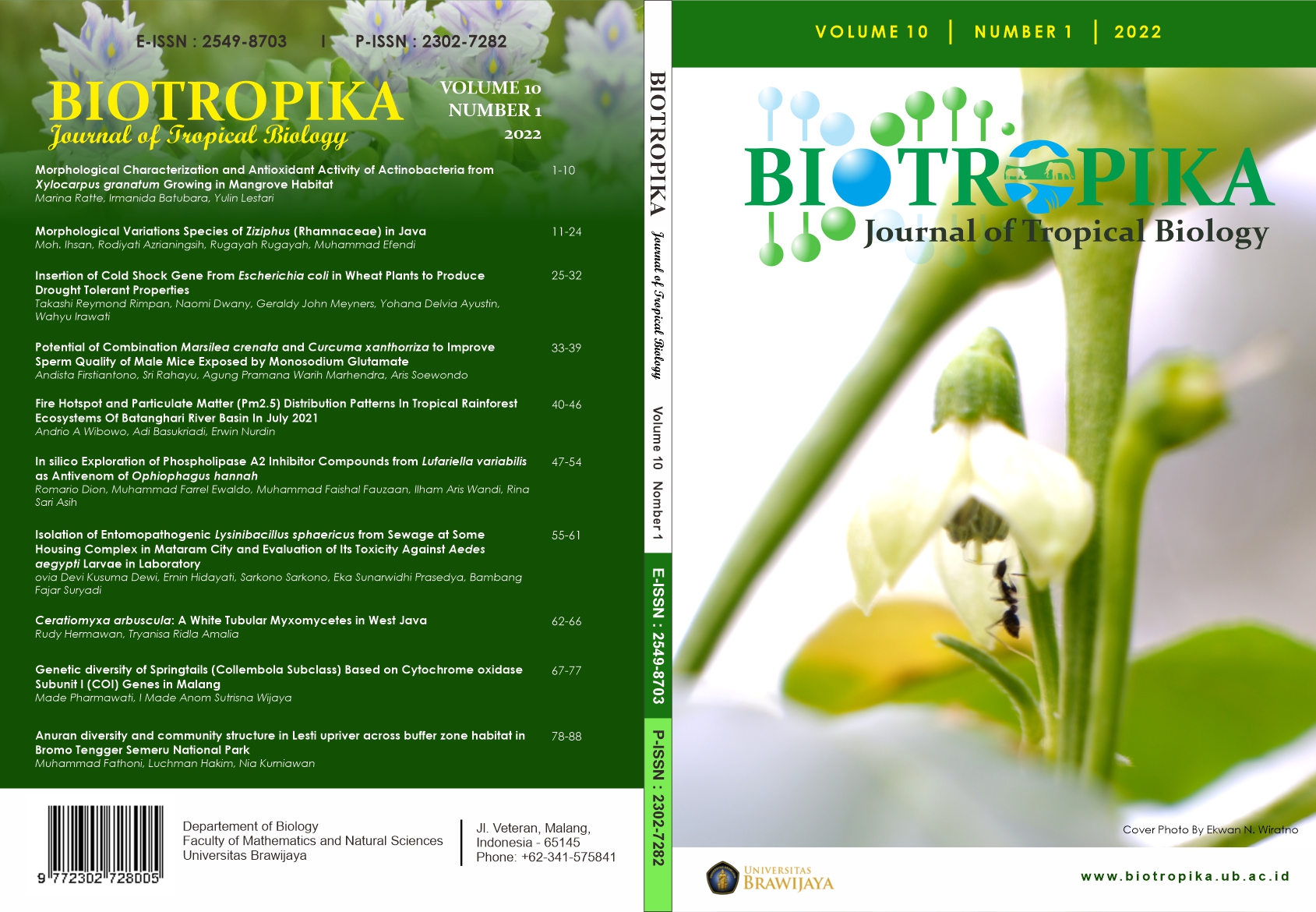<i>Ceratiomyxa arbuscula:</i> A White Tubular Myxomycetes in West Java
DOI:
https://doi.org/10.21776/ub.biotropika.2022.010.01.08Keywords:
ceratiomyxa, phenetic, slime mold, sporangiumAbstract
A white tubular Myxomycota is identic to the Ceratiomyxa genus. Ceratiomyxa has five sporangium types such as a simple pillar, fruticulus, arbuscula, filliforme, and porioides. Slime mold as Ceratiomyxa was found in IPB University. The specimen was coded as Tub1. The specimen Tub1 was found on the rotten wood and together colonized the wood as a substrate with other fungi, such as Sphaerobolus stellatus and Lentinus sajor-caju. The morphological observation was conducted, such as sporangium type, sporangium color, spore size, spore shape, and spore position of the sporangium. To identify the species, phenetic analysis was conducted for five species of Ceratiomyxa and Stemonitis fusca as an outgroup. All characters were transferred into binner data. Then, the SAHN cladogram was built using Numerical Taxonomy System (NTSys) software. The SAHN cladogram showed that Ceratiomyxa specimen Tub1 was identified as Ceratiomyxa arbuscula with a 100% similarity coefficient. The morphology supported the identification, such as the shape of arbuscula sporangium and the spore size.
References
Stephenson SL, Stempen H (1994) Myxomycetes A Handbook of Slime Molds. Timber Press, The USA.
Alexopoulos CJ, Mims CW, Blackwell M (1996) Introductory Mycology. (4th ed.). John Wiley and Sons Inc, The USA.
University of Hawai'I (2019) Myxomycota. http://www.botany.hawaii.edu/faculty/wong/Bot201/Myxomycota/Myxomycota.htm Accessed: January 2022.
Martin GW, Alexopoulos CJ (1969) The myxomycetes. University of Iowa Press, Iowa City.
Lado C (2001) Nomenmyx - A nomenclatural taxabase of myxomycetes. Cuadernos de Trabajo de Flora Mycológica Ibérica 16. Madrid, CSIC.
Index Fungorum (2022) Ceratiomyxa. http://www.indexfungorum.org/names/Names.asp Accessed: January 2022.
Hermawan R, Khairillah Y (2021) Xylaria sp.; The candle snuff fungus from West Java. Jurnal Biota 7(2): 77-84.
Hermawan R, Sari AAP (2021) Lentinus sajor-caju on the bases of morphological data. Biotika Jurnal Ilmiah Biologi 19(1): 75-79.
Hermawan R, Putra IP (2021) Calvatia rugosa: Epigeous Puffball Mushroom Reported from West Java. Science Education and Application Journal 3(1): 1–6.
Putra IP, Amelya MP, Veronica S, Kurnianto MS (2020) Fantastic fungi around us: a case study of IPB Univeristy Campus Forest. Jurnal Pena Sains 7(2): 68–82.
Hermawan R, Amelya MP, Julia ZR (2020) Trichaleurina javanica from West Java. Jurnal Mikologi Indonesia 4(2): 175–181.
Hermawan R (2020) Study of Lentinus squarrosulus from West Java on the basis of molecular and morphological data. Jurnal Biota 7(1): 1–9.
Hermawan R, Maulana I (2020) Sphaerobolus stellatus: Cannonball Mushroom from West Java. Jurnal Mikologi Indonesia 4(2): 218–222.
Hermawan R, Putra IP (2018) Calvatia pyriformis: a new record in Indonesia. Jurnal Sains Dan Teknologi 1(2): 26–29.
Hermawan R, Fusvita L, Hafizh N, Amelya MP (2021) Morphological characteristic and phenetic relationship of Lysurus periphragmoides collected from West Java. Jurnal Biodjati 6(1): 102-110.
Cavalcanti LdH, Bezerra ACC, Costa AAA, Ferreira IdN, Bezerra MdFdA (2008) Occurrence and distribution of the Ceratiomyxales (Myxomycetes) in Northeastern Brazil. Brazilian archives of biology and technology 51(5): 971-980.
Gilbert HC (1933) Critical events in the life history of Ceratiomyxa. Am J Bot 22: 52-74.
Davison EM, Davison PJN, Barret MD, Barrett RL, McMullan-Fisher SJM (2017) Additions to the Myxomycota of summer rainfall regions of tropical Australia. Nova Hedwigia, 104(1-3): 47-64.
Lado C, de Basanta DW (2008) A review of neotropical Myxomycetes (1828-2008). Anales del Jardin Botanico de Madrid 65(2): 211-254.
Dembitsky VM, Rezanka T, Spizek J, Hanus LO (2005) Secondary metabolites of slime molds (Myxomycetes). Phytochemistry 66: 747-769.
Steglich W (1989) Slime molds (myxomycetes) as a source of new biological active metabolites. Pure and Applied Chemistry 61: 281–288.
Steglich W, Steffan B, Kopanski L, Eckhardt G (1980) ZUSCHRIFTEN. Angewandte Chemie International 92: 463.
Estrada-Torres A, de Basanta DW, Lado C (2013) Biogeographic patterns of the myxomycete biota of the Americas using a parsimony analysis of endemicity. Fungal Diversity 59: 159-177.
Downloads
Published
Issue
Section
License
Copyright and Attribution:
Articles in Biotropika: Journal of Tropical Biology are under Creative Commons Attribution-NonCommercial (CC-BY-NC) copyright. The work has not been published before (except in the form of an abstract or part of a published lecture or thesis) and it is not under consideration for publication elsewhere. When the manuscript is accepted for publication in this journal, the authors agree to the automatic transfer of the copyright to the publisher.
![]() Journal of Biotropika: Journal of Tropical Biology is licensed under a Creative Commons Attribution-NonCommercial 4.0 International (CC BY-NC 4.0).
Journal of Biotropika: Journal of Tropical Biology is licensed under a Creative Commons Attribution-NonCommercial 4.0 International (CC BY-NC 4.0).
Permissions:
Authors wishing to include figures, tables, or text passages that have already been published elsewhere and by other authors are required to obtain permission from the copyright owner(s) for both the print and online format and to include evidence that such permission has been granted when submitting their papers. Any material received without such evidence will be assumed to originate from one of the authors.
Ethical matters:
Experiments with animals or involving human patients must have had prior approval from the appropriate ethics committee. A statement to this effect should be provided within the text at the appropriate place. Experiments involving plants or microorganisms taken from countries other than the author's own must have had the correct authorization for this exportation.

















